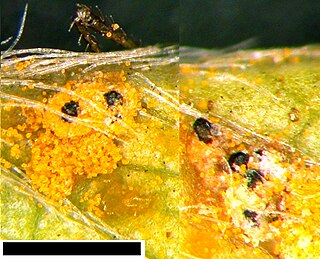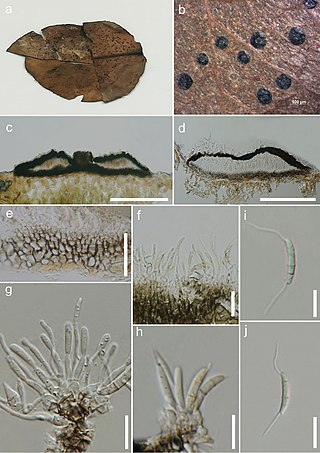
The Xylariales are an order of fungi within the class Sordariomycetes, subdivision Pezizomycotina, division Ascomycota. It was the original order of the subclass Xylariomycetidae. Xylariales was circumscribed in 1932 by Swedish mycologist John Axel Nannfeldt, and Xylariomycetidae by Ove Erik Eriksson and Katarina Winka in 1997.

The Melanommataceae are a family of fungi in the order Pleosporales. Taxa are widespread in temperate and subtropical regions, and are saprobic on wood and bark.

The Phaeosphaeriaceae are a family of fungi in the order Pleosporales. Species in the family have a cosmopolitan distribution, and are generally nectrotrophic or saprobic on a wide range of plants.

Phaeosphaeria is a genus of fungi in the family Phaeosphaeriaceae. It has about 95 species. The genus was circumscribed by Japanese mycologist Ichiro Miyake in 1909, with Phaeosphaeria oryzae assigned as the type species.
Broomella is a genus of fungi in the family Sporocadaceae.
Didymosphaeria is a genus of fungi in the family Didymosphaeriaceae.
Roussoëlla is a genus of fungi in the family Roussoellaceae. The genus is characterized by two-celled ascospores, unitunicate asci with a small spherical apical ring that stains slightly blue with Melzer's reagent, and stromata with several perithecia. The genus was circumscribed by Italian mycologist Pier Andrea Saccardo in 1888, with Roussoella nitidula assigned as the type species. The generic name honours Marietta Hannon Rousseau, (1850–1926), who was a Belgian mycologist and taxonomist.
Muyocopron is a genus of fungi in the Muyocopronaceae family.
Microthyrium is a genus of fungi in the Microthyriaceae family.

Pestalotiopsis is a genus of ascomycete fungi in the Sporocadaceae family.

Monochaetia is a genus of fungi in the family Sporocadaceae. Species in the genus are typically plant parasites and saprobes, and cause leaf spot diseases on various hosts.

Volutella is a genus of fungi belonging to the family Nectriaceae.

Dictyosporium is the type genus of fungi belonging to the family Dictyosporiaceae. By an estimate in 2018 it is formed by 45 species.
Evan Benjamin Gareth Jones is a British mycologist. His main area of research interest is aquatic fungi, particularly marine fungi. He has supervised about 100 PhD and MSc students, published approximately 600 research articles and is a highly cited scientist. Other research interests include marine biofouling, biodeterioration of materials, and wood decay by fungi.

Discosia is a genus of plant pathogens in the family Sporocadaceae.
Pararamichloridium is a genus of fungi in the monotypic family Pararamichloridiaceae and within the monotypic order of Pararamichloridiales and also in the subclass Hypocreomycetidae. They are saprobic on wood in terrestrial and freshwater habitats.









